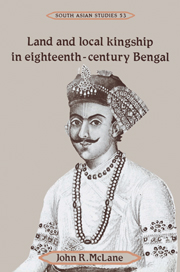Book contents
- Frontmatter
- Contents
- List of tables
- Preface and acknowledgments
- List of abbreviations
- Select glossary
- Map of southwest Bengal
- Part I Bengal
- Part II Burdwan
- 6 Mughal Burdwan and the rise of the Burdwan raj
- 7 Burdwan's expansion
- 8 The Maratha invasions, 1742-1751
- 9 Zamindars and the transition to Company rule
- 10 The famine of 1770
- 11 Revenue farming, 1771-1777
- 12 Zamindari family politics: the Burdwan raj, 1770-1775
- 13 The politics of Burdwan family debt and marriages, 1775-1778
- 14 Testing the limits, 1778–1790
- 15 Burdwan under the Decennial and Permanent Settlements
- 16 Patnis and the elusive quest for independence and security
- 17 Conclusion
- Bibliography
- Index
- Cambridge South Asian Studies
17 - Conclusion
from Part II - Burdwan
Published online by Cambridge University Press: 13 October 2009
- Frontmatter
- Contents
- List of tables
- Preface and acknowledgments
- List of abbreviations
- Select glossary
- Map of southwest Bengal
- Part I Bengal
- Part II Burdwan
- 6 Mughal Burdwan and the rise of the Burdwan raj
- 7 Burdwan's expansion
- 8 The Maratha invasions, 1742-1751
- 9 Zamindars and the transition to Company rule
- 10 The famine of 1770
- 11 Revenue farming, 1771-1777
- 12 Zamindari family politics: the Burdwan raj, 1770-1775
- 13 The politics of Burdwan family debt and marriages, 1775-1778
- 14 Testing the limits, 1778–1790
- 15 Burdwan under the Decennial and Permanent Settlements
- 16 Patnis and the elusive quest for independence and security
- 17 Conclusion
- Bibliography
- Index
- Cambridge South Asian Studies
Summary
From the sixteenth through most of the eighteenth centuries, local Hindu kingship cushioned rural Bengal's multi-cellular society from the penetration of the state and the market. Raja-zamindars reigned over societies that united Brahmins, landholding gentry, and ranked peasantry into configurations approximating the mental templates created by normative Hindu expectations of how society should function. Within zamindaris, partially autonomous rajas preserved ritual cycles, the entitlements of dependents with superior bio-moral status, and the unequal distribution of rental and tax obligations.
The imperial, foreign Mughals and British relied on the authority of local kingship in their efforts to expand territorial control, monetization, and accountancy. In permitting themselves to serve the revenue appropriation and commercial purposes of these visitors to Bengal, the zamindars entered a transformative partnership from which there was no satisfying escape. As the state pushed further into what had once been semi-independent sovereignties, the role and size of the service gentry, financiers, and merchants expanded. Patronage and political favor drew enterprising people out of parochial societies into new patterns of cooperation and rivalry over larger and larger distances. By the early eighteenth century, older ethnic and functional boundaries were losing their clarity. The Mughal government was conferring mansabdari rank on the larger zamindars of Bengal, warrior-bureaucrats were trading, western Indian bankers were instrumental in collecting the land revenue, and Bengali merchants were contracting to bring local merchandise to European trading factories.
As the Mughal government in Bengal in the early eighteenth century gained effective autonomy from Delhi, it forged a new, uneasy alliance with large zamindars who displaced the peripatetic mansabdars as the primary agency of district supervision.
- Type
- Chapter
- Information
- Land and Local Kingship in Eighteenth-Century Bengal , pp. 306 - 322Publisher: Cambridge University PressPrint publication year: 1993



